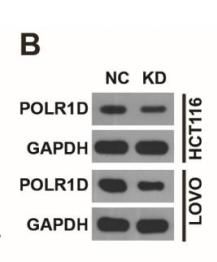POLR1D Antibody - #DF9464
Product Info
*The optimal dilutions should be determined by the end user. For optimal experimental results, antibody reuse is not recommended.
*Tips:
WB: For western blot detection of denatured protein samples. IHC: For immunohistochemical detection of paraffin sections (IHC-p) or frozen sections (IHC-f) of tissue samples. IF/ICC: For immunofluorescence detection of cell samples. ELISA(peptide): For ELISA detection of antigenic peptide.
Cite Format: Affinity Biosciences Cat# DF9464, RRID:AB_2842660.
Fold/Unfold
AC19; DNA directed RNA polymerase I 16 kDa polypeptide; DNA directed RNA polymerase I subunit D; DNA directed RNA polymerases I and III subunit RPAC2; DNA-directed RNA polymerase I subunit D; DNA-directed RNA polymerases I and III subunit RPAC2; FLJ20616; hRPA19; MGC9850; POLR1C; POLR1D; Polymerase (RNA) I polypeptide D; Polymerase (RNA) I polypeptide D, 16kDa; RNA polymerase I 16 kDa subunit; RNA polymerases I and III subunit AC2; RPA16; RPA9; RPAC2; RPAC2_HUMAN; RPC16; RPO1 3;
Immunogens
A synthesized peptide derived from human POLR1D, corresponding to a region within C-terminal amino acids.
- P0DPB5 RPC22_HUMAN:
- Protein BLAST With
- NCBI/
- ExPASy/
- Uniprot
MEEDQELERKAIEELLKEAKRGKTRAETMGPMGWMKCPLASTNKRFLINTIKNTLPSHKEQDHEQKEGDKEPAKSQAQKEENPKKHRSHPYKHSFRARGSASYSPPRKRSSQDKYEKRSNRR
- P0DPB6 RPAC2_HUMAN:
- Protein BLAST With
- NCBI/
- ExPASy/
- Uniprot
MEEDQELERKISGLKTSMAEGERKTALEMVQAAGTDRHCVTFVLHEEDHTLGNSLRYMIMKNPEVEFCGYTTTHPSESKINLRIQTRGTLPAVEPFQRGLNELMNVCQHVLDKFEASIKDYKDQKASRNESTF
Research Backgrounds
DNA-dependent RNA polymerase catalyzes the transcription of DNA into RNA using the four ribonucleoside triphosphates as substrates. Common core component of RNA polymerases I and III which synthesize ribosomal RNA precursors and small RNAs, such as 5S rRNA and tRNAs, respectively.
Nucleus.
Belongs to the archaeal RpoL/eukaryotic RPB11/RPC19 RNA polymerase subunit family.
Research Fields
· Genetic Information Processing > Transcription > RNA polymerase.
· Human Diseases > Infectious diseases: Viral > Epstein-Barr virus infection.
· Metabolism > Nucleotide metabolism > Purine metabolism.
· Metabolism > Nucleotide metabolism > Pyrimidine metabolism.
· Metabolism > Global and overview maps > Metabolic pathways.
· Organismal Systems > Immune system > Cytosolic DNA-sensing pathway. (View pathway)
References
Application: WB Species: human Sample: HCT116 and LOVO cells
Restrictive clause
Affinity Biosciences tests all products strictly. Citations are provided as a resource for additional applications that have not been validated by Affinity Biosciences. Please choose the appropriate format for each application and consult Materials and Methods sections for additional details about the use of any product in these publications.
For Research Use Only.
Not for use in diagnostic or therapeutic procedures. Not for resale. Not for distribution without written consent. Affinity Biosciences will not be held responsible for patent infringement or other violations that may occur with the use of our products. Affinity Biosciences, Affinity Biosciences Logo and all other trademarks are the property of Affinity Biosciences LTD.















